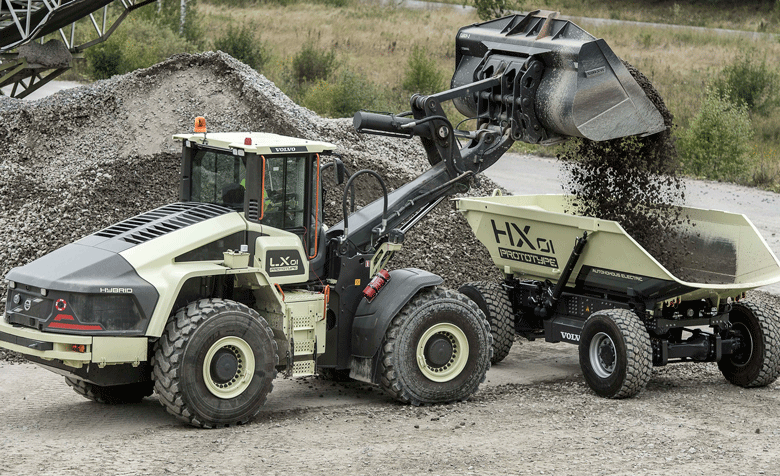

We talk about ‘automation’ as if it is a new thing, but when it comes to construction equipment automating processes has been happening for decades. The automatic gearbox and climate control are just two examples, relieving us of the responsibilities of changing gear or turning the air conditioning up and down.
What is now different is that thanks to advanced technology, the level of operator assistance is set to transform the overall productivity of machines. And it is not just productivity that will be enhanced – autonomous machines will also increase safety in hazardous working environments and eliminate the possibility of accidents caused by human error. They will also perform repetitive tasks more efficiently and precisely than a human operator. And, because machines will be operated in the most efficient way, customers benefit from improved performance, productivity, fuel efficiency and durability.
Supporting operators
Before there is an influx of fully autonomous machines on the market, we will see machines fitted with systems that are less dependent on operator skills; ones that support operators with guidance or control primary functions.
With the latest excavator digging machine control systems, such as Volvo’s Dig Assist, the operator does not need to step out of the machine in order to take measurements – because the system will have calculated exactly what material has been removed. This represents savings in time and money, as well as improving safety.
 But even this level of sophistication is not the whole automation story. There is another level – where machines ‘talk’ to each other, boosting total site productivity. Machine telematics relay large amounts of data – so much so that it can be overwhelming. What is emerging now are active monitoring services that automatically highlight problems, triggering the sending out of technicians with a detailed diagnosis of a problem and the tools and equipment to remedy it.
But even this level of sophistication is not the whole automation story. There is another level – where machines ‘talk’ to each other, boosting total site productivity. Machine telematics relay large amounts of data – so much so that it can be overwhelming. What is emerging now are active monitoring services that automatically highlight problems, triggering the sending out of technicians with a detailed diagnosis of a problem and the tools and equipment to remedy it.
But to connect business-critical machines and vehicles requires a solution that is able to handle the massive amounts of data with guaranteed connection. This month, Telia, Ericsson and Volvo CE launched Sweden’s first 5G network for industrial use, to test remote-controlled machines and autonomous solutions.
Trials are highlighting the benefits that automation brings to the construction industry. But for fully autonomous construction equipment to become commonplace, we will need to see acceptance and trust in the technology, a reduction in cost and an increase in the pace of technological change. The construction industry has a lot to learn and one way to progress quickly is to look to other sectors that already have advanced automation.
Lessons from other sectors
Industrial automation began in the manufacturing industry with the use of basic hydraulic and pneumatic systems to today’s modern robots. Now automation is revolutionising the cars themselves. The Google self-driving car project Waymo launched a commercial self-driving car service last year and other companies are following suit. One of the biggest obstacles to the technology has been public safety concerns and the legislation around it. But even here, confidence is rising as more trials end successfully. The construction industry can learn from these trials.
In a recent survey carried out on behalf of Volvo CE, almost half (46 per cent) of construction workers feared safety could be put at risk by automating tasks. These concerns are valid and need to be addressed. This is why Volvo CE is running studies with customers, such as the electric site project in cooperation with Skanska.
The study also highlighted concerns about how automation will affect job security. Machine operator roles were perceived to be most at risk – according to almost half of respondents (48 per cent). But experts agree that while the job of an operator will change with more automation, complex and unpredictable tasks will almost always require operators controlling the machines.
As machine autonomy increases, the operator will generally act more in a supervisory capacity. This will provide safer, less stressful and more interesting work for operators, with perhaps several machines being controlled remotely by one operator. In many areas of the world, such as the US, there is a shortage of skilled operators. And there are also plenty of cases where job sites are so remote, such as in Australia, that they must fly operators in and build the infrastructure they need to live while working there. Automation would provide a solution to both problems.
A look to the future
Fully autonomous machines will not arrive suddenly. The journey in the construction industry will come in stages. There will probably be a number of repetitive applications that can be performed fully autonomously, while others remain semi-autonomous for the foreseeable future.
The technology is just one part of the equation, however. Customers must want it, and while some would be happy to use the technology today, others would prefer to wait until it is more mature and affordable.
However, as costs start to fall, and as demand for efficiency, safety and productivity increases, automation is becoming an attractive and viable option in the construction sector. Change is coming – just slower than the headlines suggest.
About the author
 Uwe Müller is programme manager commercial pilots at Volvo Construction Equipment
Uwe Müller is programme manager commercial pilots at Volvo Construction Equipment
You might also like...

Red Sea Global awards Marina hotel infrastructure
18 April 2024

Aramco allows more time to revise MGS package bids
18 April 2024

Morocco tenders high-speed rail project
18 April 2024
A MEED Subscription...
Subscribe or upgrade your current MEED.com package to support your strategic planning with the MENA region’s best source of business information. Proceed to our online shop below to find out more about the features in each package.





